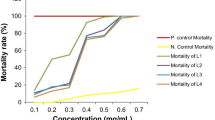Abstract
The present study was carried out to establish the larvicidal properties of crude extracts of three plants, viz. Carica papaya, Murraya paniculata and Cleistanthus collinus against Culex quinquefasciatus as target species. The relative efficacy of the plant extracts in vector control was as follows: C. papaya seed extract > M. paniculata fruit extract > M. paniculata leaf extract > C. collinus leaf extract. Result of log-probit analysis (at 95% confidence level) revealed that LC50 and LC95 values gradually decreased with the exposure periods similar to the result in bioassay experiment for each of the plant extract. The results of preliminary qualitative phytochemical analysis of all the plants revealed the presence of many bioactive principles such as steroids, alkaloids, terpenes, saponins, etc. that may be responsible for their biocontrol potentiality. The appropriate lethal concentrations at 24 h for each of the extracts were also studied on non-target organisms such as Diplonychus annulatum and Chironomus circumdatus, and no change in the swimming behaviour and survivality was noticed, which indicates that all the extracts are safe for the aquatic ecosystem.
Similar content being viewed by others
References
Abbott WS (1925) A method of computing the effectiveness of an insecticide. J Econ Entomol 18:265–266
Amer A, Mehlhorn H (2006) Larvicidal effects of various essential oils against Aedes, Anopheles, and Culex larvae (Diptera, Culicidae). Parasitol Res 99:466–472
Bhakuni DS, Dhar MM, Dhawan BN, Mehrota BN (1969) Screening of Indian plants for biological activity. Indian J Exptl Biol 7:250–253
Carvalho AFU, Melo AA, Craveiro MIL, Machado MB, Rabelo EFB (2003) Larvicidal activity of the essential oil from Lippia sidoides Cham. against Aedes aegypti L. Mem Inst OswaldoCruz 98:569–571
Chowdhury N, Ghosh A, Chandra G (2008) Mosquito larvicidal activities of Solanum villosum berry extract against the dengue vector Stegomyia aegypti. BMC Complement Altern Med 8:10 (published online)
Emeruwa AC (1982) Antibacterial substance from Carica papaya fruit extract. J Nat Prod 45:123–127
Eswarappa S, Benjamin SPE (2007) Renal failure and neuromuscular weakness in Cleistanthus collinus poisoning. J Assoc Physicians India 55:85–86
Francois G, Looveren MV, Timperman G, Chimanuka B, Assi LA, Holenz J, Bringmann G (1996) Larvicidal activity of the naphtha lisoquinoline alkaloid dioncophylline-A against the malaria vector Anopheles stephensi. J Ethnopharmacol 54(2–3):125–130
Ghosh A, Chowdhury N, Chandra G (2008) Laboratory evaluation of a phytosteroid compound of mature leaves of day jasmine (Solanaceae: Solanales) against larvae of Culex quinquefasciatus (Diptera: Culicidae) and nontarget organisms. Parasitol Res 103:221–277
Harborne JB (1984) Phytochemical methods. A guide to modern techniques of plant analysis. Chapman and Hall, London, pp 49–188
Jayaraman M, Govindaswamy S (2000) Cleistanthin A, a diphyllin glycoside from Cleistanthus collinus, is cytotoxic to PHA-stimulated (proliferating) human lymphocytes. Drug Develop Res 51:187–190
Lee SE (2000) Mosquito larvicidal activity of pipernonaline, a piperidine alkaloid derived from long pepper, Piper longum. J Am Mosq Control Assoc 16:245–247
Olagunju JA, Ogunlana CO, Gbile Z (1995) Preliminary studies on the hypoglycemic activity of ethanolic extract of unripe, mature fruits of pawpaw. Nig J Biochem Mol Biol 10:21–23
Rahuman AA, Gopalakrishnan G, Venkatesan P, Geetha K (2008a) Isolation and identification of mosquito larvicidal compound from Abutilon indicum (Linn.) Sweet. Parasitol Res 102:981–988
Rafael MS, Hereira-Rojas WJ, Roper JJ, Nunomura SM, Tadei WP (2008) Potential control of Aedes aegypti (Diptera: Culicidae) with Piper aduncum L. (Piperaceae) extracts demonstrated by chromosomal biomarkers and toxic effects on interphase nuclei. Genet Mol Res 7(3):772–781
Rahuman AA, Venkatesan P, Geetha K, Gopalakrishnan G, Bagavan A, Kamaraj C (2008b) Mosquito larvicidal activity of gluanol acetate, a tetracyclic triterpenes derived from Ficus racemosaLinn. Parasitol Res 103(2):333–339
Roark RC (1947) Some promising insecticidal plants. Econ Bot 1:437–445
Sarathchandra G, Balakrishnamoorthy P (1998) Acute toxicity of Cleistanthus collinus, an indigenous poisonous plant in Cavia porcellus. J Environ Biol 1:145–148
Shaalan EAS, Canyonb D, Younesc MWF, Abdel-Wahaba H, Mansoura AH (2005) A review of botanical phytochemicals with mosquitocidal potential. Environ Int 31:1149–1166
Stahl E (1989) Thin layer chromatography—a laboratory handbook, 2nd edn. Springer, Berlin
Sukumar K, Perich MJ, Boobar LR (1991) Botanical derivatives in mosquito control: a review. J Am Mosq Control Assoc 7:210–237
Tripathi YC, Rathore M (2001) Role of lipids in natural defense and plant protection. Indian J Forestry 24:448–455
Verma S, Rana1 TS, Ranade SA (2009) Genetic variation and clustering in Murraya paniculata complex as revealed by single primer amplification reaction methods. Curr Sci 96(9):1210–1216
World Health Organization (1981) Instructions for determining the susceptibility or resistance of mosquito larvae to insecticides. WHO/VBC/81.807. WHO, Geneva
Zolotar RM, Bykhovets AI, Kashkan ZN, Chernov YG, Kovganko NV (2002) Structure–activity relationship for insecticidal steroids. VI. 5,6-Disubstituted b-sitosterols. Chem Nat Compd 38(2):167–170
Author information
Authors and Affiliations
Corresponding author
Rights and permissions
About this article
Cite this article
Rawani, A., Haldar, K.M., Ghosh, A. et al. Larvicidal activities of three plants against filarial vector Culex quinquefasciatus Say (Diptera: Culicidae). Parasitol Res 105, 1411–1417 (2009). https://doi.org/10.1007/s00436-009-1573-z
Received:
Accepted:
Published:
Issue Date:
DOI: https://doi.org/10.1007/s00436-009-1573-z




